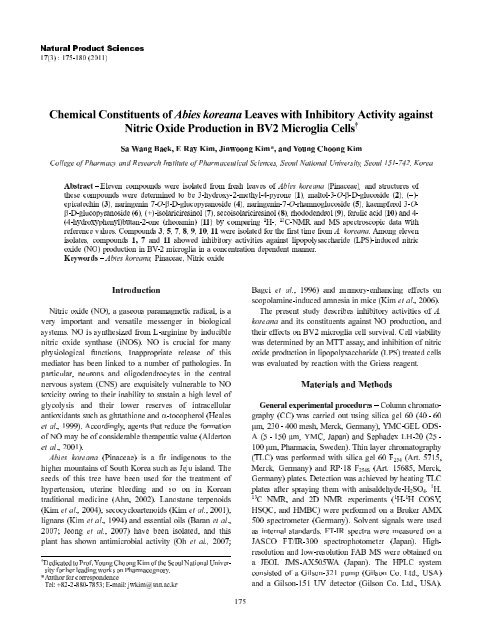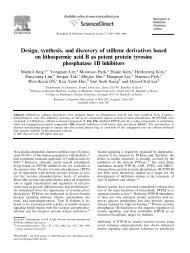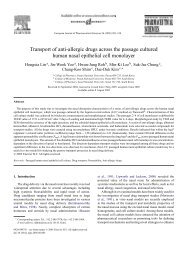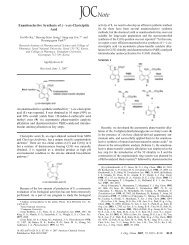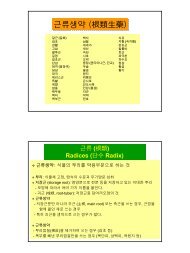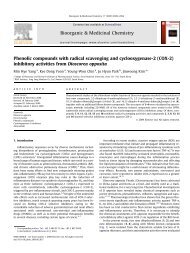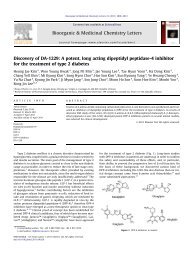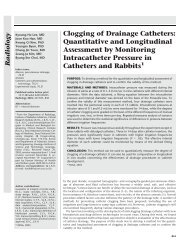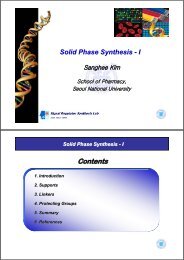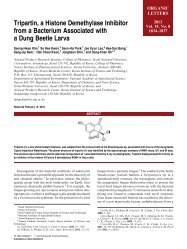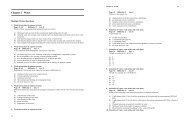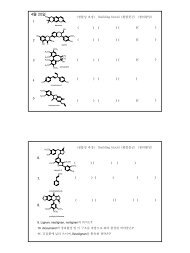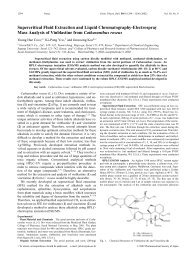Chemical Constituents of Abies koreana Leaves with Inhibitory ...
Chemical Constituents of Abies koreana Leaves with Inhibitory ...
Chemical Constituents of Abies koreana Leaves with Inhibitory ...
- No tags were found...
You also want an ePaper? Increase the reach of your titles
YUMPU automatically turns print PDFs into web optimized ePapers that Google loves.
Product SciencesNatural: 175-180 (2011)17(3)− Eleven compounds were isolated from fresh leaves <strong>of</strong> <strong>Abies</strong> <strong>koreana</strong> (Pinaceae), and structures <strong>of</strong>Abstractcompounds were determined to be 3-hydroxy-2-methyl-4-pyrone (1), maltol-3-O-β-D-glucoside (2), (−)-these(3), naringenin 7-O-β-D-glucopyranoside (4), naringenin-7-O-rhamnoglucoside (5), kaempferol 3-Oβ-D-glucopyranosideepicatechin(6), (+)-isolariciresinol (7), secoisolariciresinol (8), rhododendrol (9), ferulic acid (10) and 4-(rheosmin) (11) by comparing 1 H-, 13 C-NMR and MS spectroscopic data <strong>with</strong>(4-hydroxyphenyl)butan-2-onevalues. Compounds 3, 5, 7, 8, 9, 10, 11 were isolated for the first time from A. <strong>koreana</strong>. Among elevenreferencecompounds 1, 7 and 11 showed inhibitory activities against lipopolysaccharide (LPS)-induced nitricisolates,(NO) production in BV-2 microglia in a concentration dependent manner.oxideoxide (NO), a gaseous paramagnetic radical, is aNitricimportant and versatile messenger in biologicalveryNO is synthesized from L-arginine by induciblesystems.oxide synthase (iNOS). NO is crucial for manynitricfunctions. Inappropriate release <strong>of</strong> thisphysiologicalhas been linked to a number <strong>of</strong> pathologies. Inmediatorneurons and oligodendrocytes in the centralparticular,system (CNS) are exquisitely vulnerable to NOnervousowing to their inability to sustain a high level <strong>of</strong>toxicityand their lower reserves <strong>of</strong> intracellularglycolysissuch as glutathione and α-tocopherol (Healesantioxidantsal., 1999). Accordingly, agents that reduce the formationetNO may be <strong>of</strong> considerable therapeutic value (Alderton<strong>of</strong>al., 2001).et<strong>koreana</strong> (Pinaceae) is a fir indigenous to the<strong>Abies</strong>mountains <strong>of</strong> South Korea such as Jeju island. Thehigher<strong>of</strong> this tree have been used for the treatment <strong>of</strong>seedsuterine bleeding and so on in Koreanhypertension,medicine (Ahn, 2002). Lanostane terpenoidstraditionalet al., 2004), secocycloartenoids (Kim et al., 2001),(Kim(Kim et al., 1994) and essential oils (Baran et al.,lignansJeong et al., 2007) have been isolated, and this2007;†to Pr<strong>of</strong>. Young Choong Kim <strong>of</strong> the Seoul National UniversityDedicatedfor her leading works on Pharmacognosy.for correspondence*Author+82-2-880-7853; E-mail: jwkim@snu.ac.krTel:et al., 1996) and memory-enhancing effects onBagciamnesia in mice (Kim et al., 2006).scopolamine-inducedpresent study describes inhibitory activities <strong>of</strong> A.Theand its constituents against NO production, and<strong>koreana</strong>effects on BV2 microglia cell survival. Cell viabilitytheirdetermined by an MTT assay, and inhibition <strong>of</strong> nitricwasproduction in lipopolysaccharide (LPS) treated cellsoxideevaluated by reaction <strong>with</strong> the Griess reagent.wasexperimental procedures − Column chromatographyGeneral(CC) was carried out using silica gel 60 (40 - 60230 - 400 mesh, Merck, Germany), YMC-GEL ODS-µm,(5 - 150 µm, YMC, Japan) and Sephadex LH-20 (25 -Aµm, Pharmacia, Sweden). Thin layer chromatography100was performed <strong>with</strong> silica gel 60 F 254 (Art. 5715,(TLC)Germany) and RP-18 F 254S (Art. 15685, Merck,Merck,plates. Detection was achieved by heating TLCGermany)after spraying them <strong>with</strong> anisaldehyde-H 2 SO 4 . 1 H.platesC NMR, and 2D NMR experiments ( 1 H- 1 H COSY,13and HMBC) were performed on a Bruker AMXHSQC,spectrometer (Germany). Solvent signals were used500internal standards. FT-IR spectra were measured on aasFT/IR-300 spectrophotometer (Japan). High-JASCOand low-resolution FAB MS were obtained onresolutionJEOL JMS-AX505WA (Japan). The HPLC systema<strong>of</strong> a Gilson-321 pump (Gilson Co. Ltd., USA)consisteda Gilson-151 UV detector (Gilson Co. Ltd., USA).and<strong>Chemical</strong> <strong>Constituents</strong> <strong>of</strong> <strong>Abies</strong> <strong>koreana</strong> <strong>Leaves</strong> <strong>with</strong> <strong>Inhibitory</strong> Activity againstNitric Oxide Production in BV2 Microglia Cells †Sa Wang Baek, E Ray Kim, Jinwoong Kim*, and Young Choong KimCollege <strong>of</strong> Pharmacy and Research Institute <strong>of</strong> Pharmaceutical Sciences, Seoul National University, Seoul 151-742, KoreaKeywords − <strong>Abies</strong> <strong>koreana</strong>, Pinaceae, Nitric oxideIntroductionMaterials and Methodsplant has shown antimicrobial activity (Oh et al., 2007;175
Fig. 1. <strong>Chemical</strong> structures isolated from <strong>Abies</strong> <strong>koreana</strong>.YMC hydrosphere C 18 column (250 mm × 10 mm i.d.;Anmm) was used for isolation, and chromatograms were5at 210 nm. Recycling preparative HPLC wasmonitored<strong>with</strong> an L-6050 pump (JAI, Co. Ltd., Japan),performedUV detector and 50 RI detector, and a JAIGEL-3702BC18 column (500 mm × 50 mm i.d.; 5 µm).ODS-AP-50grade solvents (Fisher Scientific Korea Ltd., Korea)HPLCused in the CH 3 CN-H 2 O mobile phase system.werematerials − <strong>Leaves</strong> <strong>of</strong> <strong>Abies</strong> <strong>koreana</strong> E.H.Plant(Pinaceae) were collected at the Medicinal HerbWilson(Goyang-si, Gyeonggi-do), College <strong>of</strong> Pharmacy,GardenNational University in March 2008. A voucherSeoul(SNUPH-100) has been deposited at thespecimen<strong>of</strong> the Medicinal Herb Garden, College <strong>of</strong>herbariumSeoul National University.Pharmacy,and isolation − The leaves <strong>of</strong> A. <strong>koreana</strong>Extractionkg) were extracted <strong>with</strong> 80% MeOH (3 × 10 L) at(10temperature. The methanolic extract was concentratedroomvacuo to give a crude extract (989.9 g) The methanolsolubleinextract was then suspended in H 2 O and partitioned<strong>with</strong> n-hexane, ethyl acetate (EtOAc) and n-successively(n-BuOH). The EtOAc-soluble fraction wasbutanolto dryness in vacuo and yielded 186.3 g. Itevaporatedsubjected to HP-20 column chromatography <strong>with</strong> awaselution <strong>of</strong> H 2 O-MeOH to give six fractionsgradientFraction E3 was further separated by a RP-C 18(E1~6).(H 2 O : MeOH = 80 : 20→ MeOH) to give tencolumn(E3-1~10). Fraction E3-2 was purified <strong>with</strong>subfractions2 (maltol-3-O-β-D-glucoside, 54.6 mg). Fractioncompoundwas separated over a RP-C 18 column (MeCN : H 2 O=E3-3: 85) to afford compound 5 (naringenin-7-O-rhamnoglucoside,1514.9 mg) and compound 3 ((−)-epicatechin, 3.1Fraction E4 was further separated over a silica gelmg).(CHCl 3 : MeOH = 50 : 1→ MeOH) to give thirteenCC(E4-1~13). Compound 1 (3-hydroxy-2-methyl-subfractions2.9 mg) was obtained from Fraction E4-1 by4-pyrone,Fraction E4-3 was separated over a RP-recrystallization.18 column (H 2 O:MeOH=20:80→ MeOH) andCon an RP C 18 column <strong>with</strong> 70% H 2 O,rechromatographedafforded compound 9 (rhododendrol, 9.8 mg).which57.4 mg), 8 (secoisolariciresinol, 97.9 mg),(Isolariciresinol,(naringenin 7-O-β-D-glucopyranoside, 2.5 mg), and 643-O-β-D-glucopyranoside, 3.0 mg), repectively.(kaempferolE5 was further separated over a silica gel CCFraction3 : MeOH = 50 : 1 → MeOH) to give twelve(CHCl(E5-1~12). Fraction E5-4 was separated oversubfractionsRP-C 18 column (H 2 O:MeOH=20:80→ MeOH) andaon an RP C 18 column <strong>with</strong> 75% H 2 O,rechromatographedafforded compounds 10 (ferulic acid, 8.9 mg) andwhich(4-(4-hydroxyphenyl)butan-2-one, 37 mg) (Fig. 1).11Maltol (1) − White3-hydroxy-2-methyl-4-pyrone,powder; EIMS m/z : 126 [M] + ; UV λ maxamorphous176 Natural Product SciencesE4-5 and E4-10 were separated over a RP-C 18Fractions<strong>with</strong> 70% H 2 O, which afforded compounds 7columnan RP-C 18 prep. HPLC (MeCN : H 2 O = 15 : 85) to affordnm : 214.5, 276; IR ν max (KBr): 3260, 1635,(MeOH)1605, 1260, 700 cm −1 ; 1 H-NMR (500 MHz, DMSO-1612,d 6 ):δ 8.8 (1H, s, OH), 8.0 (1H, d, J = 5.5 Hz, H-5), 6.3
Table 1. The effect <strong>of</strong> compounds isolated from the leaves <strong>of</strong> A. <strong>koreana</strong> on LPS-induced NO- production in BV-2 microglia1 880.15 ± 3.29 * 891.18 ± 0.96 873.30 ± 1.79 * 86.94 ± 0.88 868.68 ± 3.30 * 82.12 ± 3.772 898.72 ± 2.14 884.75 ± 2.26 899.57 ± 0.95 77.63 ± 1.88 888.21 ± 1.59 * 78.97 ± 5.943 896.17 ± 4.64 875.53 ± 1.92 892.83 ± 0.60 70.18 ± 1.24 890.82 ± 4.82 71.53 ± 0.224 897.34 ± 1.30 878.78 ± 2.56 101.35 ± 2.67 84.29 ± 5.26 102.27 ± 4.78 77.34 ± 1.395 899.21 ± 5.15 104.91 ± 2.45 885.19 ± 5.89 99.27 ± 0.36 896.11 ± 0.95 94.75 ± 2.356 107.64 ± 1.02 885.36 ± 3.74 895.35 ± 0.79 80.35 ± 2.54 821.52 ± 0.83 ** 81.25 ± 0.927 885.71 ± 1.90 * 101.66 ± 0.92 879.78 ± 1.33 * 86.79 ± 2.34 877.57 ± 1.37 * 66.50 ± 5.258 899.65 ± 2.97 888.32 ± 0.48 899.83 ± 1.72 76.55 ± 0.23 893.18 ± 0.14 71.96 ± 1.019 895.35 ± 0.20 873.29 ± 0.51 893.38 ± 1.05 68.93 ± 2.62 886.67 ± 1.74 71.52 ± 1.5310 896.18 ± 1.85 898.65 ± 0.76 899.96 ± 5.44 89.57 ± 1.78 894.03 ± 0.94 87.59 ± 1.3711 885.85 ± 1.18 * 878.65 ± 1.42 883.69 ± 2.02 * 77.38 ± 0.70 869.49 ± 7.35 71.78 ± 2.41microglia were washed <strong>with</strong> DMEM and incubated <strong>with</strong> test compounds for 1 hr. The cultures were then stimulated by 100 ng/ml <strong>of</strong>BV-2for 24 hrs. After incubation, NO production was measured by the Griess reaction and sodium nitrite was used as a standard. NO pro-LPS(NP) <strong>of</strong> the control and the LPS-treated cultures were 5.63 ± 0.53 and 72.92 ± 1.90 µM, respectively. Relative production (%) wasductionas (NP <strong>of</strong> sample treated − NP <strong>of</strong> control) / (NP <strong>of</strong> LPS treated − NP <strong>of</strong> control) × 100. Mean value is significantly differentcalculatedd, J = 5.5 Hz, H-6), 2.2 (3H, s, CH 3 ); 13 C-NMR(1H,MHz, DMSO- d 6 ):δ 172.5 (C-4), 154.5 (C-3),(125(C-6), 142.9 (C-2), 113.5 (C-5), 13.9 (2-CH 3 ).149.2(2) − Dark brownish oil;maltol-3-O-β-D-glucosidem/z : 289 [M + H] + ; UV λ max (MeOH) nm : 276,FABMSIR ν max (KBr): 3350, 1650, 1620, 1260, 890, 705402;−1 ; 1 H-NMR (600 MHz, DMSO-d 6 ):δ 8.1 (1H, d,cm= 5.6 Hz, H-6), 6.4 (1H, d, J = 5.6 Hz, H-5), 4.7 (1H, d,J= 7.7 Hz, H-1'), 3.6 (1H, dd, J = 12.1, 2.2 Hz, H a -6'), 3.4Jdd, J = 11.8, 5.0 Hz, H b -6'), 2.4 (3H, s, CH 3 ); 13 C-(1H,(125 MHz, DMSO- d 6 ):δ 174.3 (C-4), 161.4 (C-NMR155.8 (C-6), 141.9 (C-3), 116.3 (C-5), 103.7 (C-1'),2),(C-5'), 76.3 (C-3'), 73.9 (C-2'), 69.6 (C-4'), 60.9 (C-77.315.3 (C-7).6'),(3) − Brownish syrup; EI MS m/z : 290(−)-epicatechin +; UV λ max (MeOH) nm : 279, 307; IR ν max (KBr):[M]cm −1 ; 1 H-NMR (400 MHz, CD 3 OD) : δ 6.8 (1H, d,3306= 1.6 Hz, H-2), 6.8 (1H, d, J = 8.1 Hz, H-5'), 6.7 (1H,JJ = 1.8, 8.1 Hz, H-6'), 5.9 (1H, d, J = 2.1 Hz, H-6), 5.8dd,d, J = 2.1 Hz, H-8), 4.6 (1H, d, J = 7.6 Hz, H-2), 4.0(1H,m, H-3), 2.8 (1H, J = 5.4, 16.1 Hz, H a -4), 2.5 (1H,(1H,= 8.1, 16.1 Hz, H b -4)); 13 C-NMR (125 MHz, CD 3 OD) :J157.9 (C-5), 157.6 (C-7), 156.9 (C-9), 146.3 (C-3'),δ(C-4'), 132.3 (C-1'), 120.1 (C-6'), 116.1 (C-2'),146.2(C-5'), 100.9 (C-10), 96.3 (C-6), 95.6 (C-8), 82.9115.368.9 (C-3), 28.6 (C-4).(C-2),7-O-β-D-glucopyranoside (4) − YellowishNaringeninFAB MS m/z : 435 [M + H] + ; [α] 20 D : −66.6 (c 0.3,oil;MHz, CD 3 OD) : δ 7.3 (2H, d, J = 8.6 Hz, H-2', 6'),(300(2H, d, J = 8.6 Hz, H-3', 5'), 6.2 (1H, d, J = 2.4 Hz, H-6.86.2 (1H, d, J = 2.4 Hz, H-6), 5.4 (1H, dd, J = 2.8, 12.98),H-2), 5.0 (1H, d, J = 7.3 Hz, H-1''), 3.3~3.9 (5H, m,Hz,3'', 4'' 5'', 6''), 3.2 (1H, dd, J = 12.9, 17.2 Hz, H b -3),H-2'',(1H, dd, J = 3.1, 17.2, H a -3). 13 C-NMR (125 MHz,2.73 OD) : δ 198.6 (C-4), 167.0 (C-7), 165.0 (C-5), 164.6CD159.1 (C-4'), 130.9 (C-1'), 129.1 (C-2'), 129.1 (C-(C-9),116.3 (C-3'), 116.3 (C-5'), 104.9 (C-10), 101.3 (C-1''),6'),(C-6), 96.9 (C-8), 80.7 (C-2), 78.3 (C-5''), 77.8 (C-98.01(500 MHz, CD 3 OD) : δ 7.3 (2H, d, J = 8.5 Hz,H-NMRand H-6'), 6.8 (2H, d, J = 8.5 Hz, H-3' and H-5'), 6.2H-2'd, J = 2.1 Hz, H-8), 6.1 (1H, d, J = 2.1 Hz, H-6), 5.4(1H,dd, J = 12.9, 2.5 Hz, H-2), 5.2 (1H, d, J = 1.3 Hz, H-(1H,5.1 (1H, d, J = 7.7 Hz, H-1''), 3.1 (1H, m, H a -3), 2.71'''),dd, J = 17.1, 2.8 Hz, H b -3), 1.3 (3H, d, J =6.2 Hz,(1H,13 C-NMR (125 MHz, CD 3 OD) : δ 199.3 (C-4),H-6''');(C-7), 165.7 (C-5), 165.4 (C-9), 159.9 (C-4'), 131.5167.3130.0 (C-2', 6'), 117.1 (C-3', 5'), 105.7 (C-10),(C-1'),(C-1'''), 100.1 (C-1''), 98.7 (C-6), 97.6 (C-8), 81.4103.480.0 (C-2''), 79.7 (C-5''), 78.9 (C-3''), 74.7 (C-4'''),(C-2),(C-2''', 3'''), 72.0 (C-4''), 70.8 (C-5'''), 63.1 (C-6''),73.0(C-3), 19.0 (C-6''').44.73-O-β-D-glucopyranoside (6) − YellowishKaempferolFAB MS m/z : 449 [M + H] + ; UV λ max (MeOH) nm :oil;300, 353; IR ν max (KBr): 3420, 1680, 1620, 1590,267,Vol. 17, No. 3, 2011 1771 µM 10 µM 100 µMNO (%) Viability (%) NO (%) Viability (%) NO (%) Viability (%)(*p < 0.05, **p < 0.01) from the value <strong>of</strong> the LPS-treated.74.7 (C-2''), 71.2 (C-4''), 62.4 (C-6''), 44.2 (C-3).3''),rhamnoglucoside (5) − Whitish amor-Naringenin-7-O-powder; FAB MS m/z : 379[M − H] + ; UV λ maxphousnm : 282, 326; IR ν max (KBr): 1645, 1298 cm −1 ;(MeOH)UV λ max (MeOH) nm : 228, 285, 330; IR ν maxMeOH);3300, 1615, 1570, 1520, 1050 cm −1 ; 1 H-NMR(KBr):
cm −1 ; 1 H-NMR (600 MHz, CD 3 OD) : δ 8.1 (2H, d,1510= 9.0 Hz, H-2' and H-6'), 6.9 (2H, d, J = 9.0 Hz, H-3'JH-5'), 6.4 (1H, d, J = 1.8 Hz, H-8), 6.2 (1H, d, J = 1.8andH-6), 5.3 (1H, d, J = 7.8 Hz, H-1''), 3.2~3.9 (5H, m,Hz,158.6 (C-2), 137.3 (C-3), 132.4 (C-2'), 132.4 (C-(C-9),122.9 (C-1'), 116.2 (C-3'), 116.2 (C-5'), 104.3 (C-10),6'),(C-1''), 94.9 (C-8), 78.6 (C-3''), 78.2 (C-5''), 75.9100.071.5 (C-4''), 62.8 (C-6'').(C-2''),(7) − Brownish oil; FAB MS m/z : 361Isolariciresinol +; [α] 20 D : 68.0 (c 1.0, Me 2 CO); UV λ max (MeOH)[M+H]: 220, 285; IR ν max (KBr): 3350, 1600, 1500 cm −1 ; 1 H-nm(600 MHz, CD 3 OD) : δ 6.7 (1H, d, J = 8.0 Hz, H-NMR6.7 (1H, d, J = 1.4 Hz, H-2), 6.6 (1H, s, H-2'), 6.6 (1H,5),J = 1.5, 8.0 Hz, H-6), 6.2 (1H, s, H-5'), 3.8 (1H, d,dd,= 10.7 Hz, H-7), 3.8 (3H, s, 3'-OCH 3 ), 3.8 (3H, s, 3-J3 ), 3.7 (1H, m, H-9'), 3.7 (3H, dd, J = 3.8, 10.8 Hz,OCHb -9), 3.4 (1H, dd, J = 4.0, 11.2 Hz, H a -9), 2.8 (2H, d,H= 7.7 Hz, H-7'), 2.0 (1H, m, H-8'), 1.8 (1H, m, H-8);JC-NMR (150 MHz, CD13OD) : δ 149.1 (C-3), 147.3 (C-3146.0 (C-4), 145.4 (C-4'), 138.7 (C-6'), 134.3 (C-1),3'),(C-1'), 123.3 (C-6), 117.5 (C-5'), 116.1 (C-2), 113.9129.1112.5 (C-2'), 66.1 (C-9'), 62.4 (C-9), 56.5 (OCH 3 ),(C-5),(OCH 3 ), 48.2 (C-8), 48.13 (C-7), 40.14 (C-8'), 33.756.5(C-7').(8) − Brownish oil; FAB MS m/z :Secoisolariciresinol[M + H] + ; [α 20 D : -16.0 (c 0.10, MeOH); UV λ max363nm : 226, 281; IR ν max (KBr): 3425, 1516 cm −1 ;(MeOH)1(400 MHz, CD 3 OD) : δ 6.7 (2H, d, J = 7.9 Hz,H-NMRand H-5'), 6.6 (2H, d, J = 1.9 Hz, H-2 and H-2'), 6.5H-5dd, J = 7.9, 1.9 Hz, H-6 and H-6'), 3.7 (3H, s,(2H,3 ), 3.6 (4H, m, H-9 and H-9'), 2.6 (2H, dd, J = 13.6,OCHHz, H b -7 and H-7'), 2.5 (2H, dd, J = 13.6, 7.7 Hz, H a -7.0and H-7'), 1.9 (2H, m, H-2 and H-3); 13 C-NMR7MHz, CD 3 OD) : δ 149.5 (C-3), 149.5 (C-3'), 146.1(100146.1 (C-4'), 134.6 (C-1), 134.6 (C-1'), 123.4 (C-(C-4),123.4 (C-6'), 116.6 (C-5), 116.6 (C-5'), 113.9 (C-2),6),(C-2'), 62.8 (C-9), 62.8 (C-9'), 57.0 (OCH 3 ), 57.0113.93 ), 44.8 (C-8), 44.8 (C-8'), 36.7 (C-7), 36.7 (C-7').(OCH(9) − Whitish powder; EIMS m/z : 166Rhododendrol +; UV λ max (MeOH) nm : 214.5, 276; IR ν max (KBr):[M]H-7 and H-9), 3.8 (1H, m, H-2), 2.6 (1H, t, J = 7.0Hz,H-4), 1.7 (1H, m, H-3), 1.2 (3H, d, J = 6.3 Hz, CH 3 );Hz,C-NMR (75 MHz, CD13OD) : δ 157.1 (C-8), 135.2 (C-3131.0 (C-6), 131.0 (C-10), 116.8 (C-7), 116.8 (C-9),5),(C-2), 43.2 (C-4), 33.0 (C-3), 24.3 (CH 3 ).68.7acid (10) − Yellowish powder; EI MS m/z :FerulicMHz, CD 3 OD) : δ 7.6 (1H, d, J = 15.9 Hz, H-7), 7.1(300d, J = 2.0 Hz, H-2), 7.0 (1H, dd, J = 8.1, 1.8 Hz, H-(1H,6.9 (1H, d, J = 8.1 Hz, H-5), 6.3 (1H, d, J = 15.9 Hz,6),2.9 (3H, s, OCH 3 ); 13 C-NMR (75 MHz, CD 3 OD) : δH-8),(C-9), 153.9 (C-3), 150.5 (C-7), 149.1 (C-4), 131.5173.3125.1 (C-6), 119.1 (C-5), 117.3 (C-8), 115.0 (C-2),(C-1),(OCH 3 ).58.8(11) − Brownish oil;4-(4-hydroxyphenyl)butan-2-oneMS m/z : 164 [M] + ; UV λ max (MeOH) nm : 224, 278;EIν max (KBr): 3360, 3020, 2920, 2870, 1685, 1620,IR1510, 1440, 1365, 1320, 1290, 1225, 1170, 1105,1600,960, 875, 830, 765, 730 cm −1 ; 1 H-NMR (500 MHz,1040,3 OD) : δ 7.0 (2H, d, J = 8.3, H-6 and H-10), 6.8 (2H,CDJ = 8.3, H-7 and H-9), 2.8-2.7 (4H, m, H-3 and 4), 2.1d,s, CH 3 ); 13 C-NMR (125 MHz, CD 3 OD) : δ 210.0 (C-(3H,154.5 (C-8), 132.6 (C-5), 129.5 (C-6, 10), 115.6 (C-7,2),45.6 (C-3), 30.3 (CH 3 ), 29.1 (C-4).9),<strong>of</strong> BV2 microglial cells − BV2 microglialCulturewere provided by Pr<strong>of</strong>. Sun-yeou Kim, at KyungcellsUniversity (Suwon, Korea). The cell line wasHeein DMEM containing 10% FBS <strong>with</strong>maintained(100 IU/mL) and streptomycin (10 mg/mL) atpenicillinoC in a humidified atmosphere <strong>of</strong> 95% air-5% CO 2 .37for inhibition <strong>of</strong> nitric oxide production − ToAssayany trace <strong>of</strong> phenol red, the cell cultures wereremoveand the medium was replaced <strong>with</strong> Griesswashedand further incubated <strong>with</strong> test samples and LPS.medium24 hrs incubation, 100 ul aliquots <strong>of</strong> sample wereAfter<strong>with</strong> 100 µl <strong>of</strong> Griess reagent (1% sulfanilamidemixed0.1% naphtylethylenediamine dihydrochloride, 2%andacid) in a 96 well plate and incubated at roomphosphoricfor 15 min. The absorbance at 550 nm wastemperatureon a microplate reader. The concentration wasmeasuredusing a nitrite standard curve (Dawson et al.,determined1994)viability measurements using the MTT assay −Cell100 µl aliquots <strong>of</strong> sample were collected for GriessAfterMTT (0.2 mg/mL) was directly added to cultures,assay,by incubation at 37 o C for 3 hrs. The supernatantfollowedthen aspirated and 100 µl <strong>of</strong> DMSO was added towasthe formazan. After insoluble crystals weredissolvedissolved, absorbance (abs) at 540 nm wascompletelyusing a microplate reader. Data were expressedmeasuredpercent cell viability relative to control cultures.as178 Natural Product Sciences[M] + ; UV λ max (MeOH) nm : 242, 293, 323; IR ν max1943427, 2921, 1620, 1516, 1432 cm −1 ; 1 H-NMR(KBr):3'', 4'', 5", 6''); 13 C-NMR (150 MHz, CD 3 OD) : δH-2'',(C-4), 166.1 (C-7), 163.2 (C-5), 161.7 (C-4'), 159.2179.71595, 1500 cm −1 ; 1 H-NMR (500 MHz, CD 3 OD) : δ3330,(2H, d, J = 8.4 Hz, H-6 and H-10), 6.7 (2H, d, J = 8.47.0Cell viabiltity (%) = 100 ×(Abs <strong>of</strong> LPS-treated or LPS + saple-treated)Abs <strong>of</strong> control
2. Effect <strong>of</strong> each fraction from A. <strong>koreana</strong> leaves on LPS-induced NO production in BV-2 microgliaFig.microglia were washed <strong>with</strong> DMEM and incubated <strong>with</strong> test fractions for 1 hr. The cultures were then stimulated by 100 ng/mL <strong>of</strong>BV2for 24 hrs. After incubation, NO production was measured by the Griess reaction and sodium nitrite was used as a standard. NOLPS(NP) <strong>of</strong> control and LPS-treated cultures were 1.76 ± 1.6 and 22.48 ± 1.2 µM, respectively. Relative production (%) wasproductionas (NP <strong>of</strong> sample treated - NP <strong>of</strong> control)/(NP <strong>of</strong> LPS-treated - NP <strong>of</strong> control) × 100. Mean value is significantly differentcalculated< 0.05, **p < 0.01, ***p < 0.001) from the value <strong>of</strong> the LPS-treated.(*psearch <strong>of</strong> inhibitory activity against NO productionInnatural sources, 80% MeOH extract <strong>of</strong> <strong>Abies</strong>fromdisplayed moderate inhibitory activity against<strong>koreana</strong>induced NO production in BV-2 microglia inLPSdependent manner (Fig. 2). The 80%concentrationextract <strong>of</strong> A. <strong>koreana</strong> was partitioned <strong>with</strong> n-hexane,MeOHacetate, n-buthanol and water. The ethyl acetate solubleethylshowed potent inhibitory activity against NOfractionat concentrations <strong>of</strong> 50 and 100 µg/mL. Theproductionacetate soluble fraction <strong>of</strong> the 80% MeOH extractethylA. <strong>koreana</strong> was chromatographed by repetitivefromchromatography using diverse solid absorbentscolumnsilica gel, HP-20, and RP-C 18 resin to yieldincludingcompounds (1 - 11). Isolates were identified byeleven1 H-, 13 C-NMR and MS spectroscopic datacomparingliterature values as 3-hydroxy-2-methyl-4-pyrone (1,<strong>with</strong>et al., 2001), maltol-3-O-β-D-glucoside (2, Li et al.,Kim(−)-epicatechin (3, Khallouki et al., 2007), naringenin2004),(4, Choi et al., 1990), naringenin-7-O-β-D-glucopyranoside(5, Akiyama et al., 2000), kaempferol7-O-rhamnoglucoside(6, Kovganko et al., 2002), (+)-3-O-β-D-glucopyranoside(7, Baderschneider et al., 2001), secoisola-isolariciresinol(8, Fonseca et al., 1978), rhododendrol (9, Dasriciresinolal., 1993), ferulic acid (10, Anselmi et al., 2006) and 4-etbutan-2-one (rheosmin) (11, Smith et(4-hydroxyphenyl)1996). Among eleven isolates, compounds 3, 5, andal.,cells are known as the phagocytic immuneMicroglial<strong>of</strong> the brain, and excessive activation <strong>of</strong> these cellscellsassociated <strong>with</strong> neurodegenerative disorders includingaredisease, Parkinson’s disease and ischemia.Alzheimer’striggered by various stimuli, microglial cells produceWhencytokines (interleukin-1β, interleukin-6,proinflammatorytumor necrosis factor-α (TNF-α), reactive oxygenand(ROS), and nitric oxide (NO), leading tospeciesand neurodegeneration [Eguchi et al.,neuroinflammationTherefore, it is suggested that suppression <strong>of</strong>2008].microglial cells may mitigate the progressionoveractivatedneuroinflammatory and neurodegenerative diseases.<strong>of</strong>1 - 11 were tested in vitro for theirCompoundseffects against LPS induced nitric oxideinhibitory<strong>of</strong> microglia BV2 cells. Among the isolates,production1, 7 and 11 showed inhibitory activitiescompoundsLPS induced NO production in BV-2 microglia inagainstconcentration dependent manner.aet al. (2006) demonstrated that compound 1Kangfrom four year old Panax ginseng inhibited NOisolatedfrom nitroprusside as well as simple phenolicsproductionas p-coumaric and vanillic acid. In addition, maltolsuchwere markedly increased by heat processing <strong>of</strong>levelsginseng. Even though there was a difference inPanaxconcentration, the present study is consistent <strong>with</strong>maltolreported data. (+)-Isolariciresinol (7) waspreviouslyto exert a potent in vitro inhibitory effect onreported<strong>of</strong> a pro-inflammatory cytokine, TNF-a (ChoproductionVol. 17, No. 3, 2011 179Results and discussion7-11 were isolated for the first time from <strong>Abies</strong> <strong>koreana</strong>.et al., 2001; Esra et al., 2003). It was reported that
11 inhibited NO and PGE 2 production in acompoundmanner, and also blocked LPS-induceddose-dependentand COX-2 expression in RAW 264.7 cells byiNOSNF-kB activation (Jeong et al., 2010).blockingthe present study was able to identify constituentsThus,A. <strong>koreana</strong> that inhibit NO production in BV-2<strong>of</strong>cells, and the constituents which had not beenmicrogliafrom this plant before.reportedD.K., Illistrated Book <strong>of</strong> Korean Medicinal Herbs. Kyo-HakAhn,Co., Ltd, Seoul (2002).PublishingT., Yamada, M., Yamada, T., and Maitani, T., NaringinAkiyama,α-glucosylated on ring B found in the natural foodglycosideenzymatically modified naringin. Biosci. Biotechnol.additives,64, 2246-2249 (2000).Biochem.,W.K., Cooper, C.E., and Knowles, R.G., Nitric oxide synthases:Alderton,function and inhibition. Biochem. J., 357, 593-615 (2001).structure,C., Centini, M., Ricci, M., Bupnocore, A., Granata, P., Tsuno,Anselmi,and Facino, R.M. Analytical characterization <strong>of</strong> the ferulic acid/γ-T.,inclusion complex. J. Pharm. Biomed. Anal., 40, 875-881cyclodextrin(2006).B. and Winterhalter, P., Isolation and characterization <strong>of</strong>Baderschneider,benzoates, cinnamates, flavonoids, and lignans from rieslingnoveland screening for antioxidant activity. J. Agric. Food Chem., 49,wine(2001).2788-2798E. and Digrak, M., Antimicrobial activity <strong>of</strong> essential oils <strong>of</strong> someBagci,species from Trukey. Flavour Fragr. J.,11, 251-256 (1996).<strong>Abies</strong>S., Von R., Stephan H., Konig, W.A., and Kalemba, D.,Baran,<strong>of</strong> the essential oil <strong>of</strong> <strong>Abies</strong> <strong>koreana</strong> Wils. FlavourCompositionJ.,22,78-83 (2007).Fragr.J.Y., Kim, A.R., and Park, M.H., Lignans from the rhizomes <strong>of</strong>Cho,japonica differentially act as anti-inflammatory principles.CoptisMedica, 67, 312-316 (2001).PlantaJ.S., Woo, W.S., Young H.S., and Park, J.H. Phytochemical studyChoi,Prunus davidiana. Arch. Pharm. Res., 13, 374-378 (1990).onB., Padma Rao, S., Srinivas, K.V.N.S., and Yadav, J.S., StereospecificDas,and absolute configuration <strong>of</strong> (+)-rhododendrol. Phytochemistry,synthesis1529-1530 (1993).33,H., Fujiwara, N., Sakiyama, H., Yoshihara, D., and Suzuki, K.,Eguchi,peroxide enhances LPS-induced nitric oxide production viaHydrogenexpression <strong>of</strong> interferon beta in BV-2 microglial cells. J.theExp. Neurol. 67, 1149-1158 (2008).Neuropathol.K., Nurgün E., Erdem Y., and Bilge S., Anti-inflammatory andEsraactivity <strong>of</strong> taxoids and lignans from the heartwood <strong>of</strong>antinociceptivebaccata L. J. Ethnopharmacol., 89, 265-270 (2003).TaxusS.F., De Paiva Campello, J., Barata, L.E.S., and Edmundo A.Fonseca,E.A., 13 C NMR spectral analysis <strong>of</strong> lignans from AraucariaRúveda,Phytochemistry , 17, 499-502 (1978).angustifolia.J.R., Bolanos J.P., Stewart V.C., Brooke P.S. Land J.M., and ClarkHealesNitric oxide, mitochondrial and neurological disease. Biochim.J.B.,Acta., 1410, 215-228 (1999).Biophys.S.I., Lim, J.P., and Jeon, H., <strong>Chemical</strong> composition and antibacterialJeong<strong>of</strong> the essential oil from <strong>Abies</strong> <strong>koreana</strong>. Phytother. Res., 21,activities(2007).1246-1250J.B. and Jeong, H.J., Rheosmin, a naturally occurring phenolicJeong,inhibits LPS-induced iNOS and COX-2 expression incompound264.7 cells by blocking NF-κB activation pathway. Food Chem.RAW48, 2148-2153 (2010).Toxicol.,K.S., Yokozawa, T., Kim, H.Y., and Park, J.H., Study on the nitricKang,scavenging effects <strong>of</strong> ginseng and its compounds. J. Agric.oxideChem., 54, 2558-2562 (2006).FoodF., Haubner, R., Hull, W.E., Erben, G., Spiegelhalder, B.,Khallouki,H., and Owen, R.W., Isolation, purification and identificationBartsch,ellagic acid derivatives, catechins, and procyanidins from the root<strong>of</strong><strong>of</strong> Anisophyllea dichostyla R. Br., Food Chem. Toxicol., 45, 472-bark(2007). 485H.J., Choi, E.H., and Lee, I.S., Two lanostane triterpenoids fromKim,<strong>koreana</strong>. Phytochemistry, 65, 2545-2549 (2004).<strong>Abies</strong>H.J., Le, Q.K., Lee, M.H., Kim, T.S., Lee, H.K., Kim, Y.H., Bae, K.,Kim,Lee, I.S., A cytotoxic secocycloartenoid from <strong>Abies</strong> <strong>koreana</strong>.andPharm. Res., 24, 527-531 (2001).Arch.K., Bu, Y., Jeong, S., Lim, J., Kwon, Y., Cha, D.S., Kim, J., Jeon, S.,Kim,J., and Jeon, H., Memory-enhancing effect <strong>of</strong> a supercriticalEun,dioxide fluid extract <strong>of</strong> the needles <strong>of</strong> <strong>Abies</strong> <strong>koreana</strong> oncarbonamnesia in mice. Biosci. Biotechnol. Biochem.,scopolamine-induced1821-1826 (2006).70,Y.G., Lee, H., Ozawa, S., Sasaya, T., and Moon, C.K., Lignans <strong>of</strong>Kim,<strong>koreana</strong> Wilson. Mokuzai Gakkaishi, 40, 414-418 (1994).<strong>Abies</strong>N.V., Kashkan, Z.N., and Krivenok, S.N., Bioactive substancesKovganko,the flora Belarus. Chem. Nat. Compounds, 38, 328-330 (2002).<strong>of</strong>W.W. and Huang, W.P., Synthesis <strong>of</strong> maltol and maltol-3-β-D-Li,Chin. J. Syn. Chem., 12, 391-393 (2004).glucoside.H.J., Ahn, H.M., So, K.H., Kim, S.S., Yun P.Y., Jeon, G.L., and Riu,Oh,<strong>Chemical</strong> and antimicrobial properties <strong>of</strong> essential oils fromK.Z.,coniferous trees <strong>Abies</strong> Koreana, Cryptomeria japonica, andthreenucifera. J. Appl. Biol. Chem., 50, 164-169(2007).TorreyaL.R., Rheosmin (“Raspberry ketone”) and zingerone, and theirSmith,by crossed aldol-catalytic hydrogenation sequences.preparationEduc., 1, 1-18 (1996).Chem.July 20, 2011ReceivedAugust 20, 2011Revised180 Natural Product SciencesReferencesAccepted August 25, 2011


